初中英语语法名词篇(教师版,含答案)
- 格式:docx
- 大小:49.93 KB
- 文档页数:14
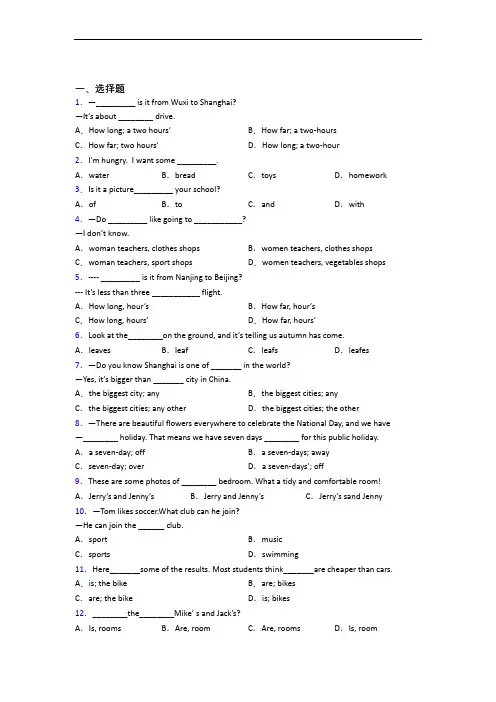
一、选择题1.—_________ is it from Wuxi to Shanghai?—It’s about ________ drive.A.How long; a two hours’B.How far; a two-hoursC.How far; two hours’D.How long; a two-hour2.I’m hungry. I want some _________.A.water B.bread C.toys D.homework 3.Is it a picture_________ your school?A.of B.to C.and D.with 4.—Do _________ like going to ___________?—I don’t know.A.woman teachers, clothes shops B.women teachers, clothes shops C.woman teachers, sport shops D.women teachers, vegetables shops 5.---- _________ is it from Nanjing to Beijing?--- It’s less than three ___________ flight.A.How long, hour’s B.How far, hour’sC.How long, hours’D.How far, hours’6.Look at the________on the ground, and it’s telling us autumn has come. A.leaves B.leaf C.leafs D.leafes 7.—Do you know Shanghai is one of _______ in the world?—Yes, it’s bigger than _______ city in China.A.the biggest city; any B.the biggest cities; anyC.the biggest cities; any other D.the biggest cities; the other 8.—There are beautiful flowers everywhere to celebrate the National Day, and we have —________ holiday. That means we have seven days ________ for this public holiday. A.a seven-day; off B.a seven-days; awayC.seven-day; over D.a seven-days’; off9.These are some photos of ________ bedroom. What a tidy and comfortable room! A.Jerry’s and Jenny’s B.Jerry and Jenny’s C.Jerry’s sand Jenny 10.—Tom likes soccer.What club can he join?—He can join the ______ club.A.sport B.musicC.sports D.swimming11.Here_______some of the results. Most students think_______are cheaper than cars. A.is; the bike B.are; bikesC.are; the bike D.is; bikes12.________the________Mike’ s and Jack’s?A.Is, rooms B.Are, room C.Are, rooms D.Is, room13._______mother usually cooks for_______ at the weekend.A.Lily and Nick; their B.Lily's and Nick's; themC.Lily and Nick's; their D.Lily and Nick's; them14.—How many________ doctors are there in your hospital?—________ them________ over one hundredA.woman; The number of; is B.women; The number of; isC.women; A number of; are15.— How _______ is it from Xi'an to Dunhuang? — It's less than 3 _______ flight. A.long; hour's B.far; hour's C.long; hours' D.far, hours' 16.— Is this room yours? —No, it's not__________.It's __________.A.mine; Lily's and Lucy's B.my; Lily and Lucy'sC.my; theirs D.mine; Sally's17.I’m happy ________ a friend of ________.A.to visit, my B.visiting my C.to visit, mine D.visiting, my 18.—May I take your order,sir? —________.A.Chicken with vegetables and two bowls of ricesB.Chicken with vegetables and two bowls of riceC.Chickens with vegetable and two bowl of ricesD.Chickens with vegetables and two bowls of rices19.—What would you like for breakfast? —I'd like ________.A.tomato noodle B.tomato noodlesC.tomatoes noodle D.tomatoes noodles20.--What kind of noodles you like?--I’d like noodles.A.do;tomatoes B.would;tomato C.do;tomato D.would;tomatoes 21.One of the ________ was late for the game yesterday.A.plays B.player C.playing D.players 22.These aren’t.They’re my brother’s.A.pen;mine B.pens;mineC.pen;my D.pens;my23.Learning English in a classroom is important, but using English in real ________ will improve skills greatly.A.conditions B.situations C.events D.positions 24.That is my ________ and my ________ are on it.A.desk; books B.desks; book C.desks; books D.desk, book 25.—What can I do for you?—Err, I want a glass of milk, some bread and .A.some chickens B.any chicken C.some chicken【参考答案】***试卷处理标记,请不要删除一、选择题1.C解析:C【解析】【分析】【详解】句意:——从无锡到上海有多远?——大约两小时的车程。
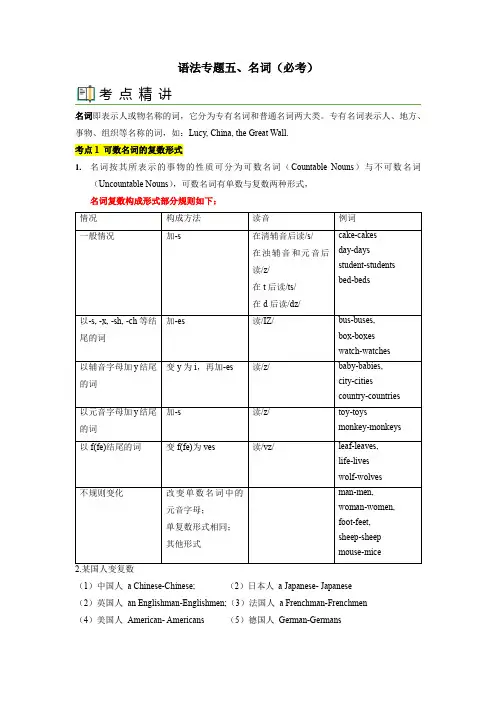
语法专题五、名词(必考)名词即表示人或物名称的词,它分为专有名词和普通名词两大类。
专有名词表示人、地方、事物、组织等名称的词,如:Lucy, China, the Great Wall.考点1 可数名词的复数形式1.名词按其所表示的事物的性质可分为可数名词(Countable Nouns)与不可数名词(Uncountable Nouns),可数名词有单数与复数两种形式,名词复数构成形式部分规则如下:情况构成方法读音例词一般情况加-s在清辅音后读/s/在浊辅音和元音后读/z/在t后读/ts/在d后读/dz/cake-cakes day-days student-students bed-beds以-s, -x, -sh, -ch等结尾的词加-es读/IZ/bus-buses,box-boxeswatch-watches以辅音字母加y结尾的词变y为i,再加-es读/z/baby-babies,city-citiescountry-countries以元音字母加y结尾的词加-s读/z/toy-toysmonkey-monkeys以f(fe)结尾的词变f(fe)为ves读/vz/leaf-leaves,life-liveswolf-wolves不规则变化改变单数名词中的元音字母;单复数形式相同;其他形式man-men, woman-women, foot-feet, sheep-sheep mouse-mice2.某国人变复数(1)中国人a Chinese-Chinese; (2)日本人a Japanese- Japanese (2)英国人an Englishman-Englishmen;(3)法国人a Frenchman-Frenchmen (4)美国人American- Americans (5)德国人German-Germans 考点精讲可用口诀记忆这一点,即:中日不变英法变,其余s加后面。
3.以-o结尾的名词,有些在词尾加-es,它们是“黑人英雄爱吃西红柿土豆”。
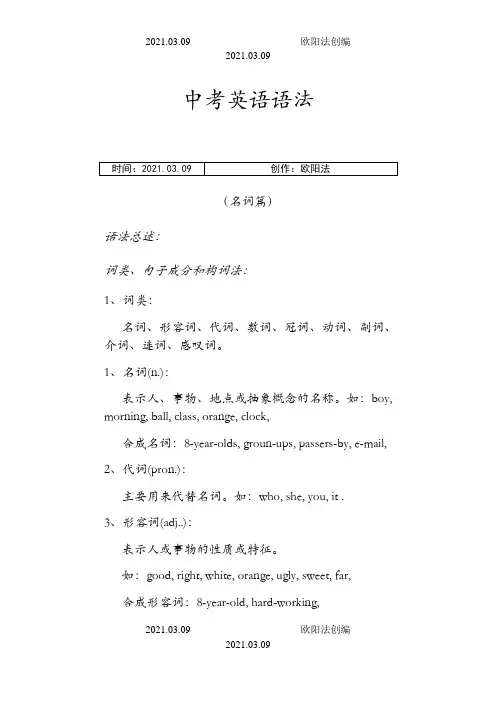
中考英语语法(名词篇)语法总述:词类、句子成分和构词法:1、词类:名词、形容词、代词、数词、冠词、动词、副词、介词、连词、感叹词。
1、名词(n.):表示人、事物、地点或抽象概念的名称。
如:boy, morning, ball, class, orange, clock,合成名词:8-year-olds, groun-ups, passers-by, e-mail, 2、代词(pron.):主要用来代替名词。
如:who, she, you, it .3、形容词(adj..):表示人或事物的性质或特征。
如:good, right, white, orange, ugly, sweet, far,合成形容词:8-year-old, hard-working,2021.03.09 欧阳法创编4、数词(num.):表示数量或事物的顺序。
基数词:one, two, three, hundred,序数词:first, second, third,量词:a piece of, two bottles of, three basket of, four bowls of, five cups of,six pairs of,5、动词(v.):表示动作或状态。
系词:am, is,are,半系词:look, sound, feel, get, become, keep, stay, taste, smell, turn,实意动词:have, see , think, beat, walk,助动词:辅助动词构成否定、疑问等语气,辅助东西构成时态语态等。
如:be,do,does,did,will,can,should,may,6、副词(adv.):修饰动词、形容词或其他副词,说明时间、地点、程度等。
如:now, here, often, quietly, slowly, home, upstairs, hard, very, really,7、冠词(art..):用在名词前,帮助说明名词。
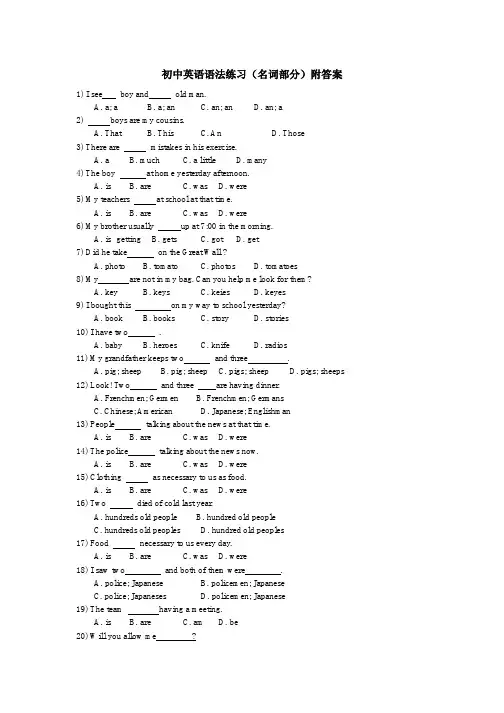
初中英语语法练习(名词部分)附答案1) I see boy and old man.A. a; aB. a; anC. an; anD. an; a2) boys are my cousins.A. ThatB. ThisC. AnD. Those3) There are mistakes in his exercise.A. aB. muchC. a littleD. many4) The boy at home yesterday afternoon.A. isB. areC. wasD. were5) My teachers at school at that time.A. isB. areC. wasD. were6) My brother usually up at 7:00 in the morning.A. is gettingB. getsC. gotD. get7) Did he take on the Great Wall ?A. photoB. tomatoC. photosD. tomatoes8) My are not in my bag. Can you help me look for them?A. keyB. keysC. keiesD. keyes9) I bought this on my way to school yesterday?A. bookB. booksC. storyD. stories10) I have two .A. babyB. heroesC. knifeD. radios11) My grandfather keeps two and three .A. pig; sheepB. pig; sheepC. pigs; sheepD. pigs; sheeps12) Look! Two and three are having dinner.A. Frenchmen; GermenB. Frenchmen; GermansC. Chinese; AmericanD. Japanese; Englishman13) People talking about the news at that time.A. isB. areC. wasD. were14) The police talking about the news now.A. isB. areC. wasD. were15) Clothing as necessary to us as food.A. isB. areC. wasD. were16) Two died of cold last year.A. hundreds old peopleB. hundred old peopleC. hundreds old peoplesD. hundred old peoples17) Food necessary to us every day.A. isB. areC. wasD. were18) I saw two and both of them were .A. police; JapaneseB. policemen; JapaneseC. police; JapanesesD. policemen; Japanese19) The team having a meeting.A. isB. areC. amD. be20) Will you allow me ?A. to shake hand with youB. to shake hands with youC. to shake a handD. shaking hands with you21) Browns went to the south for the winter vacation.A. ThisB. TheC. AnD. A22) On Teacher’s Day, we often buy gifts for our teachers.A. /B. theC. AnD. A23) After several years’ self-study he got knowledge.A. manyB. muchC. lot ofD. any24) I have some problems with my English writing. Can you give me some .A. decisionsB. informationC. messagesD. advice25) I have money. Can you borrow me some?.A. fewB. littleC. manyD. much26) He is a friend of ?.A. IB. meC. mineD. my27) mothers can’t come to the meeting because they have gone to Beijing.A. Tom’s and JimB. Tom’s and Jim’sC. Tom and JimD. Tom and Jim’s28) It’s bedroom. It’s clean and tidy.A. Sally’s and JaneB. Sally’s and Jane’sC. Sally and JaneD. Sally and Jane’s29) It’s from our school to my home.A. ten minutes’ walkB. ten minute’s walkC. ten minutes walkD. ten minute walk30) Please show us a map the world.A. onB. ofC. aroundD. about31) They were at the yesterday.A. doctorB. doctorsC. doctor’sD. bookstores32) Could you tell me the way the park? I’m new here.A. inB. onC. toD. of33) She lost the key her room just now.A. withB. ofC. inD. to34) Eating too much bad for your health.A. beB. areC. isD. were35) The woman behind the girls a famous actress.A. beB. areC. isD. were36) The old man raises many to make a living on the farm.A. horseB. birdC. duckD. sheep37) —How many teachers are there in your school?—them over two hundred.A.woman; The number of; isB. women; The number of; isC. woman; A number of; isD. women; A number of; are38) I like a lot, and my mother usually cooks it in different way.A. fishB. butterC. noodlesD. tomatoes39) John wants to be a , so he often helps sick people in the hospital.A. reporterB. scientistC. teacherD. doctor答案1.B2.D3.D4.C5.D6.B7.C8.B9.A 10.D11.C 12.B 13.D 14.B 15.A 16.B 17.A 18.B 19.B 20.B 21.B 22.A 23.B 24.D 24.B 26.C 27.B 28.D 29.A 30.B 31.C 32.C 33.D 34.C 35.C 36.D 37.B 38.A 39.D。
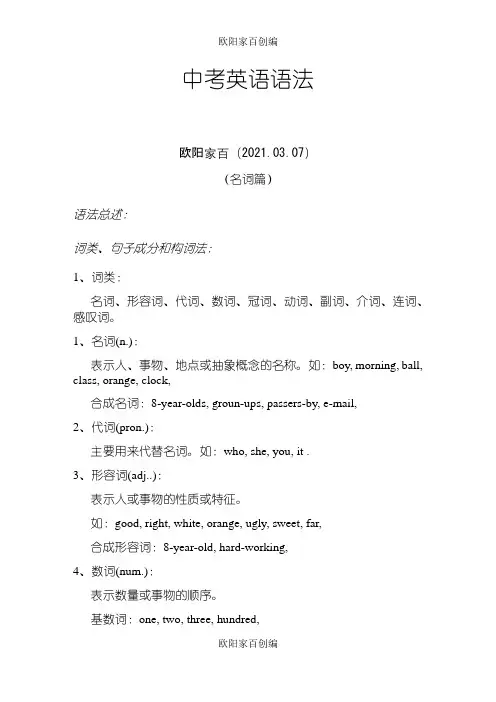
中考英语语法欧阳家百(2021.03.07)(名词篇)语法总述:词类、句子成分和构词法:1、词类:名词、形容词、代词、数词、冠词、动词、副词、介词、连词、感叹词。
1、名词(n.):表示人、事物、地点或抽象概念的名称。
如:boy, morning, ball, class, orange, clock,合成名词:8-year-olds, groun-ups, passers-by, e-mail,2、代词(pron.):主要用来代替名词。
如:who, she, you, it .3、形容词(adj..):表示人或事物的性质或特征。
如:good, right, white, orange, ugly, sweet, far,合成形容词:8-year-old, hard-working,4、数词(num.):表示数量或事物的顺序。
基数词:one, two, three, hundred,序数词:first, second, third,量词:a piece of, two bottles of, three basket of, four bowls of, five cups of,six pairs of,5、动词(v.):表示动作或状态。
系词:am, is,are,半系词:look, sound, feel, get, become, keep, stay, taste, smell, turn,实意动词:have, see , think, beat, walk,助动词:辅助动词构成否定、疑问等语气,辅助东西构成时态语态等。
如:be,do,does,did,will,can,should,may,6、副词(adv.):修饰动词、形容词或其他副词,说明时间、地点、程度等。
如:now, here, often, quietly, slowly, home, upstairs, hard, very, really, 7、冠词(art..):用在名词前,帮助说明名词。
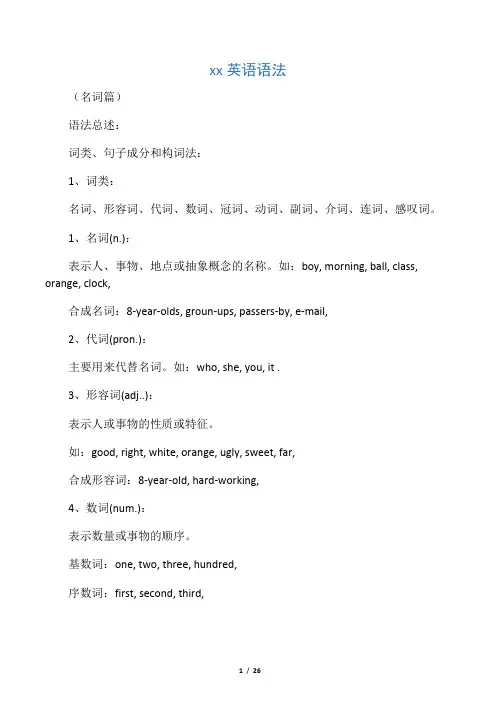
xx英语语法(名词篇)语法总述:词类、句子成分和构词法:1、词类:名词、形容词、代词、数词、冠词、动词、副词、介词、连词、感叹词。
1、名词(n.):表示人、事物、地点或抽象概念的名称。
如:boy, morning, ball, class, orange, clock,合成名词:8-year-olds, groun-ups, passers-by, e-mail,2、代词(pron.):主要用来代替名词。
如:who, she, you, it .3、形容词(adj..):表示人或事物的性质或特征。
如:good, right, white, orange, ugly, sweet, far,合成形容词:8-year-old, hard-working,4、数词(num.):表示数量或事物的顺序。
基数词:one, two, three, hundred,序数词:first, second, third,量词:a piece of, two bottles of, three basket of, four bowls of, five cups of, six pairs of,5、动词(v.):表示动作或状态。
系词:am, is,are,实意动词:have, see , think, beat, walk,助动词:辅助动词构成否定、疑问等语气,辅助东西构成时态语态等。
如:be, do, does, did, will, can, should, may,6、副词(adv.):修饰动词、形容词或其他副词,说明时间、地点、程度等。
如:now, here, often, quietly, slowly, home, upstairs, hard, very, really,7、冠词(art..):用在名词前,帮助说明名词。
如:a, an, the.8、介词(prep.):表示它后面的名词或代词与其他句子成分的关系。
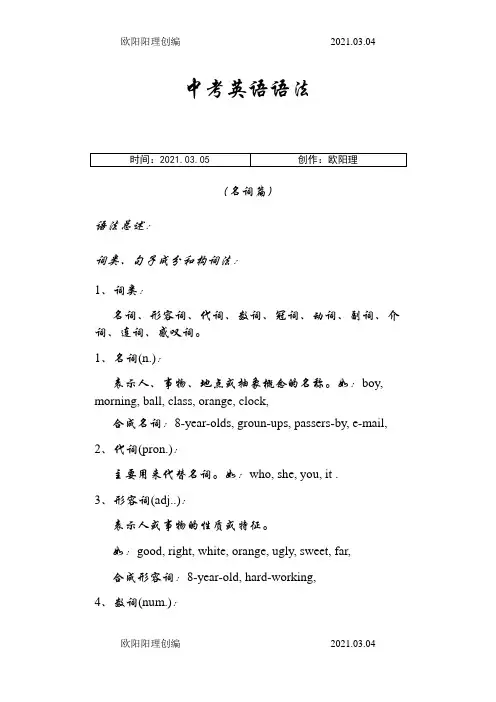
中考英语语法(名词篇)语法总述:词类、句子成分和构词法:1、词类:名词、形容词、代词、数词、冠词、动词、副词、介词、连词、感叹词。
1、名词(n.):表示人、事物、地点或抽象概念的名称。
如:boy, morning, ball, class, orange, clock,合成名词:8-year-olds, groun-ups, passers-by, e-mail,2、代词(pron.):主要用来代替名词。
如:who, she, you, it .3、形容词(adj..):表示人或事物的性质或特征。
如:good, right, white, orange, ugly, sweet, far,合成形容词:8-year-old, hard-working,4、数词(num.):表示数量或事物的顺序。
基数词:one, two, three, hundred,序数词:first, second, third,量词:a piece of, two bottles of, three basket of, four bowls of, five cups of,six pairs of,5、动词(v.):表示动作或状态。
系词:am, is,are,半系词:look, sound, feel, get, become, keep, stay, taste, smell, turn,实意动词:have, see , think, beat, walk,助动词:辅助动词构成否定、疑问等语气,辅助东西构成时态语态等。
如:be,do,does,did,will,can,should,may,6、副词(adv.):修饰动词、形容词或其他副词,说明时间、地点、程度等。
如:now, here, often, quietly, slowly, home, upstairs, hard, very, really,7、冠词(art..):用在名词前,帮助说明名词。
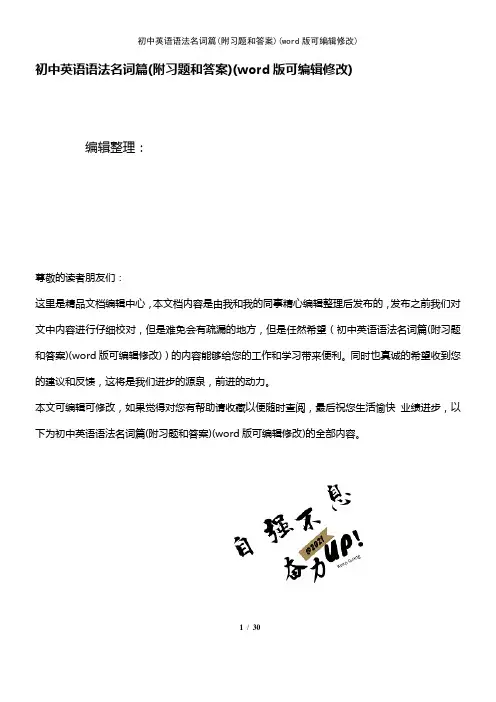
初中英语语法名词篇(附习题和答案)(word版可编辑修改)编辑整理:尊敬的读者朋友们:这里是精品文档编辑中心,本文档内容是由我和我的同事精心编辑整理后发布的,发布之前我们对文中内容进行仔细校对,但是难免会有疏漏的地方,但是任然希望(初中英语语法名词篇(附习题和答案)(word版可编辑修改))的内容能够给您的工作和学习带来便利。
同时也真诚的希望收到您的建议和反馈,这将是我们进步的源泉,前进的动力。
本文可编辑可修改,如果觉得对您有帮助请收藏以便随时查阅,最后祝您生活愉快业绩进步,以下为初中英语语法名词篇(附习题和答案)(word版可编辑修改)的全部内容。
1/ 30中考英语语法(名词篇)语法总述:词类、句子成分和构词法:1、词类:名词、形容词、代词、数词、冠词、动词、副词、介词、连词、感叹词.1、名词(n。
):表示人、事物、地点或抽象概念的名称。
如:boy, morning, ball, class, orange, clock,合成名词:8-year-olds, groun-ups, passers—by, e-mail,2、代词(pron。
):主要用来代替名词。
如:who, she, you, it .3、形容词(adj。
):表示人或事物的性质或特征.如:good, right, white, orange, ugly, sweet, far,合成形容词:8-year—old, hard—working,4、数词(num。
):表示数量或事物的顺序.基数词:one, two, three, hundred,序数词:first, second, third,量词:a piece of, two bottles of, three basket of, four bowls of, five cups of,six pairs of,5、动词(v.):表示动作或状态。
系词:am, is,are,2/ 30半系词:look, sound, feel, get, become, keep, stay, taste, smell, turn,实意动词:have, see , think, beat, walk,助动词:辅助动词构成否定、疑问等语气,辅助东西构成时态语态等。
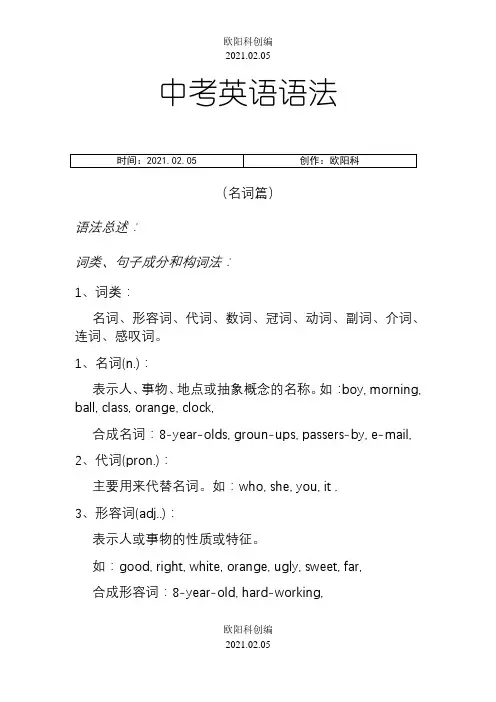
中考英语语法(名词篇)语法总述:词类、句子成分和构词法:1、词类:名词、形容词、代词、数词、冠词、动词、副词、介词、连词、感叹词。
1、名词(n.):表示人、事物、地点或抽象概念的名称。
如:boy, morning, ball, class, orange, clock,合成名词:8-year-olds, groun-ups, passers-by, e-mail,2、代词(pron.):主要用来代替名词。
如:who, she, you, it .3、形容词(adj..):表示人或事物的性质或特征。
如:good, right, white, orange, ugly, sweet, far,合成形容词:8-year-old, hard-working,欧阳科创编4、数词(num.):表示数量或事物的顺序。
基数词:one, two, three, hundred,序数词:first, second, third,量词:a piece of, two bottles of, three basket of, four bowls of, five cups of,six pairs of,5、动词(v.):表示动作或状态。
系词:am, is,are,半系词:look, sound, feel, get, become, keep, stay, taste, smell, turn,实意动词:have, see , think, beat, walk,助动词:辅助动词构成否定、疑问等语气,辅助东西构成时态语态等。
如:be,do,does,did,will,can,should,may,6、副词(adv.):修饰动词、形容词或其他副词,说明时间、地点、程度等。
如:now, here, often, quietly, slowly, home, upstairs, hard, very, really,7、冠词(art..):用在名词前,帮助说明名词。
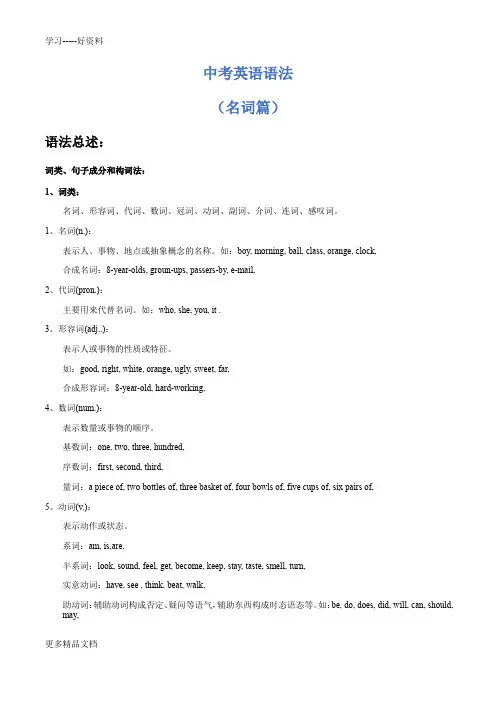
中考英语语法(名词篇)语法总述:词类、句子成分和构词法:1、词类:名词、形容词、代词、数词、冠词、动词、副词、介词、连词、感叹词。
1、名词(n.):表示人、事物、地点或抽象概念的名称。
如:boy, morning, ball, class, orange, clock,合成名词:8-year-olds, groun-ups, passers-by, e-mail,2、代词(pron.):主要用来代替名词。
如:who, she, you, it .3、形容词(adj..):表示人或事物的性质或特征。
如:good, right, white, orange, ugly, sweet, far,合成形容词:8-year-old, hard-working,4、数词(num.):表示数量或事物的顺序。
基数词:one, two, three, hundred,序数词:first, second, third,量词:a piece of, two bottles of, three basket of, four bowls of, five cups of, six pairs of,5、动词(v.):表示动作或状态。
系词:am, is,are,半系词:look, sound, feel, get, become, keep, stay, taste, smell, turn,实意动词:have, see , think, beat, walk,助动词:辅助动词构成否定、疑问等语气,辅助东西构成时态语态等。
如:be, do, does, did, will, can, should, may,6、副词(adv.):修饰动词、形容词或其他副词,说明时间、地点、程度等。
如:now, here, often, quietly, slowly, home, upstairs, hard, very, really,7、冠词(art..):用在名词前,帮助说明名词。
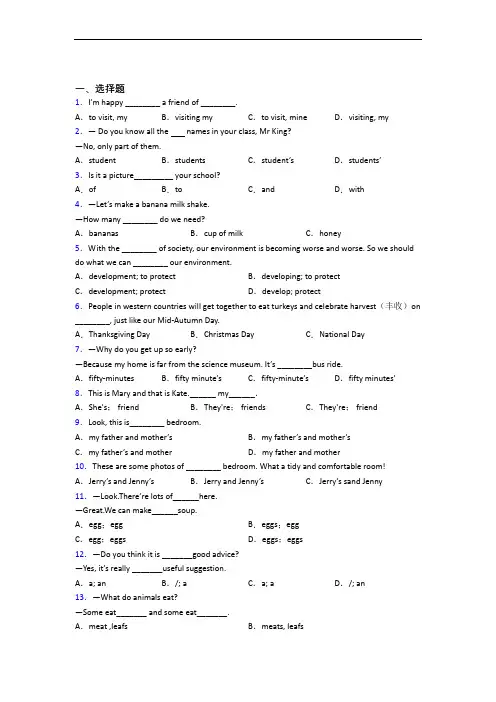
一、选择题1.I’m happy ________ a friend of ________.A.to visit, my B.visiting my C.to visit, mine D.visiting, my 2.— Do you know all the names in your class, Mr King?—No, only part of them.A.student B.students C.student’s D.students’3.Is it a picture_________ your school?A.of B.to C.and D.with4.—Let’s make a banana milk shake.—How many ________ do we need?A.bananas B.cup of milk C.honey5.With the ________ of society, our environment is becoming worse and worse. So we should do what we can ________ our environment.A.development; to protect B.developing; to protect C.development; protect D.develop; protect6.People in western countries will get together to eat turkeys and celebrate harvest(丰收)on ________, just like our Mid-Autumn Day.A.Thanksgiving Day B.Christmas Day C.National Day7.—Why do you get up so early?—Because my home is far from the science museum. It’s ________bus ride.A.fifty-minutes B.fifty minute’s C.fifty-minute’s D.fifty minutes’8.This is Mary and that is Kate.______ my______.A.She's; friend B.They're; friends C.They're; friend 9.Look, this is________ bedroom.A.my father and mother’s B.my father’s and mother’sC.my father’s and mother D.my father and mother10.These are some photos of ________ bedroom. What a tidy and comfortable room! A.Jerry’s and Jenny’s B.Jerry and Jenny’s C.Jerry’s sand Jenny 11.—Look.There’re lots of______here.—Great.We can make______soup.A.egg;egg B.eggs;eggC.egg;eggs D.eggs;eggs12.—Do you think it is _______good advice?—Yes, it’s really _______useful suggestion.A.a; an B./; a C.a; a D./; an 13.—What do animals eat?—Some eat_______ and some eat_______.A.meat ,leafs B.meats, leafsC.meat ,leaves D.meats ,leaves14.—________ shows are getting more and more popular.—That's true. And many people are truly________.A.Talent; talent B.Talent; talented C.Talented; talented D.Talented; talent 15.—May I take your order,sir? —________.A.Chicken with vegetables and two bowls of ricesB.Chicken with vegetables and two bowls of riceC.Chickens with vegetable and two bowl of ricesD.Chickens with vegetables and two bowls of rices16.—What would you like for breakfast? —I'd like ________.A.tomato noodle B.tomato noodlesC.tomatoes noodle D.tomatoes noodles17.One of the ________ was late for the game yesterday.A.plays B.player C.playing D.players 18.Animals are our ________, and we should be ________ to them.A.friend; friendly B.friends; friendly C.friendly; friends D.friendly; friend 19.Let’s wish the food festival .A.succeed B.success C.successful20.________he_______big________?A.Does; has; foot B.Does; have; feet C.Do; have; foots21.This zebra is an ______ animal. It lives in ______ now.A.Africa; Africa B.African; AfricaC.Africa; African D.African; African22.Learning English in a classroom is important, but using English in real ________ will improve skills greatly.A.conditions B.situations C.events D.positions23.In fact, he didn’t explain the cause the accident us clearly.A.for; to B.of; to C.for; for D.of; for 24.—How far is it from here to the hospital? —It’s about ride.A.fifteen minute’s B.fifteen minutesC.fifteen minutes’D.fifteen-minutes25.Peter would like a bowl of ________noodles.A.tomato and egg B.tomato and eggsC.tomatoes and eggs D.tomatoes and egg【参考答案】***试卷处理标记,请不要删除一、选择题1.C解析:C【解析】【分析】【详解】句意:我很开心去拜访我的一个朋友。
中考英语语法(名词篇)语法总述:词类、句子成分和构词法:1、词类:名词、形容词、代词、数词、冠词、动词、副词、介词、连词、感叹词。
1、名词(n.):表示人、事物、地点或抽象概念的名称。
如:boy, morning, ball, class, orange, clock,合成名词:8-year-olds, groun-ups, passers-by,e-mail,2、代词(pron.):主要用来代替名词。
如:who, she, you, it .3、形容词(adj..):表示人或事物的性质或特征。
如:good, right, white, orange, ugly, sweet, far,合成形容词:8-year-old, hard-working,4、数词(num.):表示数量或事物的顺序。
基数词:one, two, three, hundred,序数词:first, second, third,量词:a piece of, two bottles of, three basket of, four bowls of, five cups of,six pairs of,5、动词(v.):表示动作或状态。
系词:am, is,are,半系词:look, sound, feel, get, become, keep, stay, taste, smell, turn,实意动词:have, see , think, beat, walk,助动词:辅助动词构成否定、疑问等语气,辅助东西构成时态语态等。
如:be,do,does,did,will,can,should,may,6、副词(adv.):修饰动词、形容词或其他副词,说明时间、地点、程度等。
如:now, here, often, quietly, slowly, home,upstairs, hard, very, really,7、冠词(art..):用在名词前,帮助说明名词。
中考英语语法(名词篇)语法总述:词类、句子成分和构词法:1、词类:名词、形容词、代词、数词、冠词、动词、副词、介词、连词、感叹词。
1、名词(n.):表示人、事物、地点或抽象概念的名称。
如:boy, morning, ball, class, orange, clock,合成名词:8-year-olds, groun-ups, passers-by, e-mail, 2、代词(pron.):主要用来代替名词。
如:who, she, you, it .3、形容词(adj..):表示人或事物的性质或特征。
如:good, right, white, orange, ugly, sweet, far,合成形容词:8-year-old, hard-working,欧阳治创编2021.03.104、数词(num.):表示数量或事物的顺序。
基数词:one, two, three, hundred,序数词:first, second, third,量词:a piece of, two bottles of, three basket of, four bowls of, five cups of,six pairs of,5、动词(v.):表示动作或状态。
系词:am, is,are,半系词:look, sound, feel, get, become, keep, stay, taste, smell, turn,实意动词:have, see , think, beat, walk,助动词:辅助动词构成否定、疑问等语气,辅助东西构成时态语态等。
如:be,do,does,did,will,can,should,may,6、副词(adv.):修饰动词、形容词或其他副词,说明时间、地点、程度等。
如:now, here, often, quietly, slowly, home, upstairs, hard, very, really,7、冠词(art..):用在名词前,帮助说明名词。
中考英语语法(名词篇)语法总述:词类、句子成分和构词法:1、词类:名词、形容词、代词、数词、冠词、动词、副词、介词、连词、感叹词。
1、名词(n.):表示人、事物、地点或抽象概念的名称。
如:boy, morning, ball, class, orange, clock,合成名词:8-year-olds, groun-ups, passers-by, e-mail,2、代词(pron.):主要用来代替名词。
如:who, she, you, it .3、形容词(adj..):表示人或事物的性质或特征。
如:good, right, white, orange, ugly, sweet, far, 合成形容词:8-year-old, hard-working,4、数词(num.):表示数量或事物的顺序。
基数词:one, two, three, hundred,序数词:first, second, third,量词:a piece of, two bottles of, three basket of, four bowls of, five cups of,six pairs of,5、动词(v.):表示动作或状态。
系词:am, is,are,半系词:look, sound, feel, get, become, keep, stay, taste, smell, turn,实意动词:have, see , think, beat, walk,助动词:辅助动词构成否定、疑问等语气,辅助东西构成时态语态等。
如:be,do,does,did,will,can,should,may,6、副词(adv.):修饰动词、形容词或其他副词,说明时间、地点、程度等。
如:now, here, often, quietly, slowly, home, upstairs, hard, very, really,7、冠词(art..):用在名词前,帮助说明名词。
初中中考英语语法(名词篇)语法总述:词类、句子成分和构词法:1、词类:名词、形容词、代词、数词、冠词、动词、副词、介词、连词、感叹词。
1、名词(n.):表示人、事物、地点或抽象概念的名称。
如:boy, morning, ball, class, orange, clock,合成名词:8-year-olds, groun-ups, passers-by, e-mail,2、代词(pron.):主要用来代替名词。
如:who, she, you, it .3、形容词(adj..):表示人或事物的性质或特征。
如:good, right, white, orange, ugly, sweet, far,合成形容词:8-year-old, hard-working,4、数词(num.):表示数量或事物的顺序。
基数词:one, two, three, hundred,序数词:first, second, third,量词:a piece of, two bottles of, three basket of, four bowls of, five cups of, six pairs of,5、动词(v.):表示动作或状态。
系词:am, is,are,半系词:look, sound, feel, get, become, keep, stay, taste, smell, turn,实意动词:have, see , think, beat, walk,助动词:辅助动词构成否定、疑问等语气,辅助东西构成时态语态等。
如:be, do, does, did, will, can, should, may,6、副词(adv.):修饰动词、形容词或其他副词,说明时间、地点、程度等。
如:now, here, often, quietly, slowly, home, upstairs, hard, very, really,7、冠词(art..):用在名词前,帮助说明名词。
如:a, an, the.8、介词(prep.):表示它后面的名词或代词与其他句子成分的关系。
如in, on, at, from, above, under, behind, with, without, to,短语介词:next to, in front of, at the age of,9、连词(conj.):用来连接词、短语或句子。
如and, or, before, when, while, after, as soon as, if, unless,until, because, so, though, but, even if, even though, as if,10、感叹词(interj..):表示喜、怒、哀、乐等感情。
如:oh, well, hi, hello2、构词法:英语构词法主要有:合成法、派生法和转换法。
1、合成法:如:spaceship, headache, basketball, playground等等。
2、派生法:(1)派生名词:①动词+er/or ②动词+ing ③动词+(t)ion ④形容词+ness ⑤其他,如:inventor, learner, swimming, congratulation, kindness, carelessness, knowledge(2)派生形容词:①名词+y ②名词+ful ③动词+ing/ed ④friendly ⑤dangerous ⑥Chinese; Japanese ⑦English ⑧French ⑨German ⑩国名+(i)an 如:snowy, sunny, hopeful, beautiful, interesting, follwing,daily(每日的),nervous, delicious(3)派生副词:①形容词+ly ②其它,如:slowly, angrily, full→fully, good→well, possible→possibly等等。
3、转换法:(1)形容词→动词,如:dry(干燥的)→dry(弄干), clean(干净的)→clean(打扫,弄干净),等等。
(2)动词→名词,如:look, walk, rest, work, study, swim, go, talk等等。
(3)名词→动词,如:hand(手)→(传递),face(脸)→(面对)等等。
(4)形容词→副词,如:early→early, fast→fast等等。
(5)副词→连词,如:when(什么时候)→(当……时候),等等。
(6)介词→副词,如:in(到……里)→(在里面;在家),on(在…上)→(进行,继续),等等。
名词篇:名词的种类:英语名词可分专有名词和普通名词两大类:专有名词普通名词国名,地名,人名, 团体,机构名称可数名词不可数名词个体名词集体名词抽象名词物质名词1、专有名词是个别的人、地、物、团体、机构等的专用名称。
专有名词中实词的第一个字母要大写。
如:Jilin, Tom, China,(1)零冠词,如Yale University,Beijing Railway Station,是由专有名词+普通名词组成,往往为并列关系。
(2)定冠词,如the United States,the Great Wall,由形容词+普通名词组成。
(3) 姓氏名如果采用复数形式,则表示该姓氏一家人(复数含义),如:the Greens( 格林一家人)。
2、普通名词是许多人或事物的共有名称。
普通名词又可进一步分为四类1) 个体名称: 表示单个的人和事物。
house 马car 汽车room 房间apple 苹果fun 风扇picture 照片2) 集体名称: 表示一群人或一些事物的名称。
people 人们family 家庭army 军队government 政府group 集团3) 物质名词:表示物质或不具备确定形状和大小的个体的物质。
fire 火steel 钢air 空气water 水milk 牛奶4)抽象名词:表示动作,状态,品质或其他抽象概念。
labour 劳动health 健康life 生活friendship友情patience耐力3. 普通名词又分为可数名词和不可数名词。
可数名词是可以用简单的数词进行计数的名词,如:box, child, orange;不可数名词是不可以用简单的数词进行计数的名词。
如:water, news, oil, population, information .4、英语可数名词的单复数:英语可数名词有单数和复数两种形式。
1. 规则名词的复数形式:规则例词1 一般情况在词尾加-s map-maps, sea-seas, girl-girls, day-days2 以s, x, ch, sh结尾的名词后加-es class-classes, box-boxes, watch-watches, dish→dishes, bench→benches, glasses, dresses, wishes, faxes3 以-f或-fe结尾的词变-f和-fe为v再加-esleaf-leaves, thief-thieves, knife-knives, loaf-loaves,wife-wives, shelf→shelves, wolf→wolves, life→lives,half-halves, leaf-leaves, yourself-yourselves加-sbelief-beliefs, chief-chiefs, proof-proofs, roof-roofs,gulf-gulfs,4 以辅音字母加y结尾的名词,变y为i加-es party-parties, family-families, story-stories, city-cities, baby-babies, duty-duties, comedy-comedies, documentary-documentaries5 以元音字母加y结尾的名词,或专有名词以y结尾的,加-stoy-toys, boy-boys, day-days, ray-rays, Henry-Henrys,toy-toys, key-keys, ways6 以辅音字母加-o结尾的名词一般加-eshero-heroes, Negro-Negroes, potato-potatoes,tomato-tomatoes不少外来词加-spiano-pianos, photo-photos, auto-autos, kilo-kilos,solo-solos两者皆可zero-zeros /zeroes, volcano-volcanoes/ volcanos7 以元音字母加-o结尾的名词加-s radio-radios, bamboo-bamboos, zoo-zoos2. 不规则名词复数:英语里有些名词的复数形式是不规则的,现归纳如下:规则例词1 改变名词中的元音字母或其他形式man-men, woman-women, foot-feet, goose-geese, mouse-mice, man→men, woman→women, sheep→sheep, tooth→teeth, child→children, goose→geese2 单复数相同sheep, deer, series, means, works, fish, species li, yuan, jin,3 只有复数形式ashes, trousers, clothes, thanks, goods, glasses, compasses, contents4 一些集体名词总是用作复数cattle, staff5 部分集体名词既可以作单数(表整体)也可以作复数(表其中的人或者成员)audience, class, family, crowd, couple, group, committee,government, population, crew, team, public, enemy, party,police警察局,警察, class班,同学, family家,家庭成员6 复数形式表示特别含义customs(海关), forces(军队), times(时代), spirits(情绪), drinks(饮料), sands(沙滩), papers(文件报纸), manners(礼貌), looks(外表), brains(头脑智力), greens(青菜), ruins(废墟)7 表示“某国人”加-sAmericans, Australians, Germans, Greeks, Swedes,Europeans单复数同形Swiss, Portuguese, Chinese, Japanese, sheep, deer, fish, 以-man或-woman结尾的改为-men,-womenEnglishmen, Frenchwomen8 合成名词将主体名词变为复数sons-in-law, lookers-on, passers-by, story-tellers, boy friends无主体名词时将最后一部分变为复数grown-ups, housewives, stopwatches9 名词作定语把主要名词变成复数,做定语的名词一把用单数a boy student- some boy students,an apple tree-some appletrees, a shoe factory- some shoe factories, an eight-year-oldboy,名词作定语将两部分都变为复数a woman singer-women singers, a man teacher-men teachers, 名词作定语, a sports bag-two sports bag, a clothes store-two clothes stores10 常以复数形式出现scissors 剪刀goods 货物trousers 裤子glasses 玻璃杯people,pants, shorts, shoes, glasses, gloves, clothes, socks11 单复数意义不同fish鱼fishes鱼的种类, paper纸papers报纸,卷子,论文, work工作works作品,工厂, glass玻璃glasses玻璃杯,眼镜, orange桔子水oranges橙子, light光线lights灯, people人peoples民族, time时间times时代, 次数, chicken 鸡肉chickens 小鸡5、名词所有格:名词在句中表示所属关系的语法形式叫做名词所有格,相当于物主代词,在句中作定语、宾语或主语。